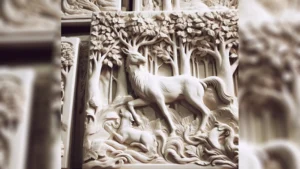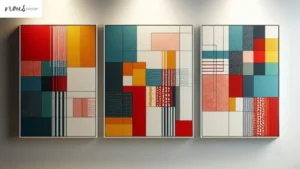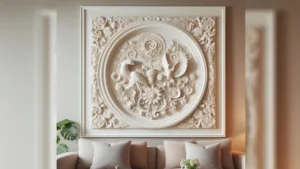When it comes to decorating a room with higher ceilings or large walls, there’s no denying that a blank wall can be intimidating. But fear not! In this article, we’ll explore different ways to transform that bland empty space of yours into a stunning focal point that elevates your style and adds character to your home with the right Wall Art For High Ceilings.
From choosing the right scale to mixing and matching styles for a cohesive look, we’ll provide tips and inspiration for creating a showstopping display that reflects your unique taste and personality. So grab a cup of coffee (or tea) and let’s get started with Nousdecor on transforming those bare walls into works of art.
Takeaways
- High ceilings offer endless creative opportunities for those seeking to adorn their living spaces with captivating artwork.
- Large canvas pieces, specifically designed to complement such soaring heights, can transform a room with striking visual impact.
- On the other hand, vertical wall sculptures, when strategically placed, create stunning focal points that draw the eye upwards, making the most of the vertical space.
- Additionally, gallery wall displays can bring a sense of coziness to high ceilings, effectively breaking up the expanse and infusing warmth into the environment.
- The choice of materials for wall art significantly affects its overall aesthetics, and when combined with thoughtful lighting effects, can highlight the artwork beautifully. With these insights, exploring the world of wall art for high ceilings becomes an exciting journey of creativity and expression.
Choosing the Right Wall Art For High Ceilings
Picking the perfect size of unique home wall art for your space can be tricky, but it’s crucial to make sure your wall decor doesn’t look out of place.
- One of the best measuring techniques is to use a tape measure and mark off the dimensions on your panel with painter’s tape. This will give you a visual representation of how much space you have to work with.
- Another important factor when choosing the right scale for your space is color palettes. If you have neutral walls, consider adding a pop of color to your artwork.
- On the other hand, if your walls are already bold and colorful, opt for more subdued pieces that won’t clash or compete with the existing colors in the room.
By incorporating ideas for tall wall decor and different textures and materials into your wall decor, you can create a dynamic centerpiece in any room. Choose one main feature to match your home’s aesthetic—perhaps a tapestry or a large painting that accentuates the ceiling height, making the room feel more intimate.
A clever way to break up the expansive wall space is by arranging furniture rather than relying solely on hanging pieces. Decorate tall walls with shelves or fabrics that also use contrasting textures to bring warmth and depth to the space. As a seller of style, remember you don’t need to fill every space—sometimes less is more, allowing each chosen element to stand out on its own.
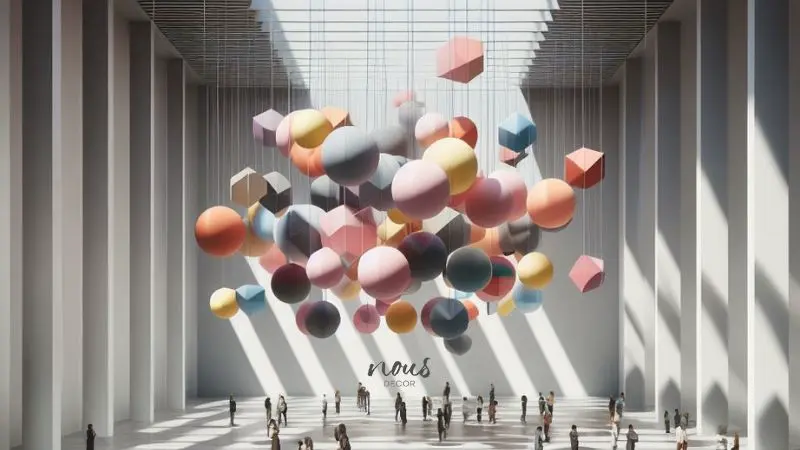
Incorporating Unique Wall Decor Sculptures & 3D Art
Incorporating unique sculptures and stylish 3D wall art is an excellent way to add visual interest to any high-ceilinged room. Here are four things to keep in mind when incorporating 3D art into your high-ceilinged room:
- 3D vs. Traditional: Comparing Art Styles – While traditional art is flat and often two-dimensional, 3D art adds depth and texture to any space.
- Finding Inspiration: Unique Designs – Look for unconventional materials such as metal or wood or opt for more whimsical designs like animal heads or abstract art and wallpaper.
- Placement Matters – Consider where you want to place your work; placing it at eye level can help it stand out while hanging it higher up can draw attention upward.
- Pair with Complimentary Items – Incorporate other design elements that compliment your work such as a rug, curtains, moldings, or patterned throw pillows.
As we move on, keep in mind how these unique sculptural pieces can play off of each other visually for added dimensionality within your space!
Creating a Gallery Wall for Maximum Impact & Tone
Creating a gallery wall is an excellent way to showcase your art collection while also adding depth and dimension to your high-ceilinged room.
- To make the most impact with your collection, consider using art framing techniques that create a dynamic composition.
- Mixing different sizes and shapes of frames can add visual interest to your interior design. Additionally, playing around with different frame styles can give your display a unique touch.
- Incorporating light fixtures into your wall can further enhance the artwork’s beauty by highlighting particular pieces or creating shadows that add depth.
However, these are just one way to elevate your high-ceilinged room’s style! Using oversized paintings as centerpieces can also be an impactful choice when trying out new decor ideas for this type of space.
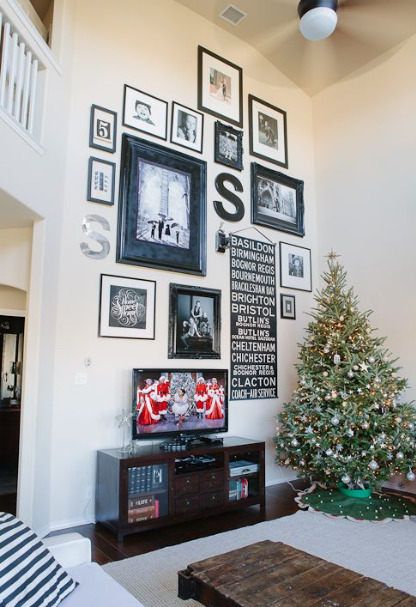
Using Large-Scale Paintings as Focal Points to Decorate
If you want to make a statement in your spacious room, using statement pieces is the way to do it.
- Oil paintings are perfect if you’re looking for rich colors and consistency, while acrylics offer a more modern feel with their vibrant hues and glossy finish.
- Photography prints could also work if you want a more personal touch, especially if you have taken the photo yourself or commissioned an artist to take one for you.
- When displaying one large piece of art, make sure that there’s enough negative space around it so that it doesn’t look cramped or cluttered.
- You should also consider the lighting in the room – natural light brings out the best in oil paintings while artificial light works well with photography prints.
By using these tips and tricks, you can elevate your style and create a bold statement piece that will be admired by all who enter your space.
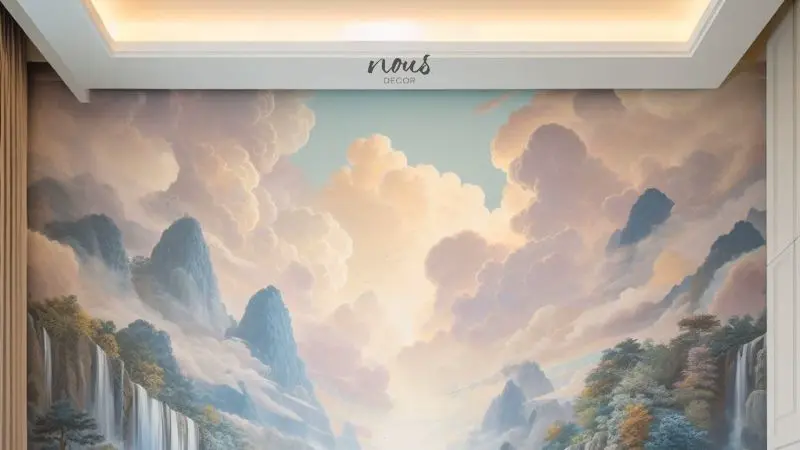
Mixing & Matching Styles for a Cohesive Look
WIn the vast canvas of a room graced with extremely high ceilings, decorating your tall walls becomes an adventure in style and scale.
- Embrace ceiling-tall wall decor ideas that encourage a sense of harmony while highlighting the grandeur of your space.
- An eclectic mix of art styles, from the crisp lines of modern pieces to the rich narratives of traditional paintings, can create a dynamic visual feast that draws the eye.
- As a savvy shopper on platforms like Etsy or Wayfair, choose art that’s large enough to look intentional and commanding.
- A well-placed ladder against the wall can serve as a good way to add interest and functionality, allowing you to switch out decor as you’d like.
- Remember, it’s not about filling every inch of tall space but rather curating a collection that makes your home feel uniquely aligned with your vision. Blend in furniture that complements your decor, choosing pieces that resonate with the shapes and sizes of your room.
By incorporating these approaches, you’ll transform your bedroom with art for bedroom walls or any room with towering walls into an exquisite reflection of your personal taste.
Frequently Asked Questions
Conclusion
In conclusion, harness these strategies to enhance your abode with flair, employing grand wall decor for lofty walls and ceilings.
Ponder the room’s proportions and ceiling altitude when selecting decor to match the grandeur of your space. Embrace distinctive sculptures and three-dimensional art to introduce texture and life to your walls. Assemble a gallery wall for a striking visual collective, perfect for exhibiting an array of artworks. Opt for commanding paintings to create focal points that guide the eye to desired spaces. Blend various styles for a unified aesthetic that mirrors your unique preferences.
Embolden your living areas, from lounges to dining spaces and sleeping quarters, into a captivating visual narrative.
Stir your imagination and refine your habitat with exquisite wall art. Now is the moment to ignite inspiration and ascend to new heights of interior elegance.
Elevate your abode with high ceiling tall wall decor that transforms your space into a statement of style. For rooms with high ceilings, a large vertical artwork serves as a perfect complement, leading the eyes upward and making the space feel both grand and cozy.
Consider a floor-to-ceiling bookcase that not only breaks up the wall but also adds a classic look with its geometric designs. Incorporate a chic chandelier that acts as a big statement piece, while various-sized murals add a splash of bright colors, creating a timeless aesthetic. By choosing decor that matches the scale of the wall, like side by side vertical pieces or a striking fireplace, you curate a room that feels uniquely yours, cozy yet far from sterile.

